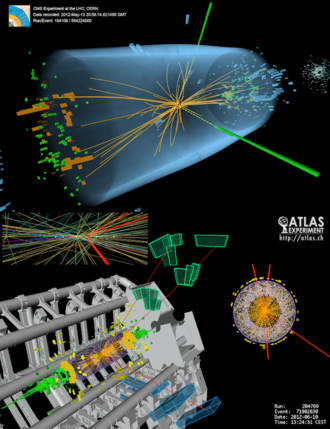Did Higgs's boson blow mass to material?
Higgs boson is an interesting, high-energy particle. The existence of that particle is very short. The extremely high energy level of Higgs boson causes a situation where it sends wave movement to space that surrounds it. That quantum field causes a situation. Where the quantum vacuum rips Higgs's boson in pieces. And that shockwave interacts with its environment. That forms some short-term particles and virtual particles in the impact point of the shockwave.
The reason for that is the Higgs's boson's extremely high energy level. The energy level determines the speed at which energy can travel out from the particle.
And there is the possibility that there is only one or two particles between the photon and the Higgs boson. The idea is that Higgs's boson is a particle that turns into a photon through the particle. That we can call "X". The particle X would be at a higher energy level than Higgs's boson. The idea is that the size of the particle decreases or the particle turns smaller when its energy level rises. So the light cone can show how the particle's size turns smaller when its energy level turns higher. Then sooner or later, the particle turns as small as it can. And in that moment the quantum field inside the particle travels outside.
Then suddenly, decreasing size removes mass from the particle and turns it into a photon. In some models, there is a possibility that the particle will turn so small that it decreases its quantum field. So the particle loses its mass or its quantum field fills it. That means the particle and its quantum field turn into one entirety when the particle's energy level is high enough.
*****************************************************************
The gravitational waves can slow the particle.
In this model the particle is hollow. The particle itself looks like a whisk. The quantum fields impact that particle causing reflection that is seen as gravitational waves. Gravitational waves transport energy out from particles.
And that thing causes a quantum shadow that puts energy travel into the particle. In this model, energy moves back and forth in and out of particles. Every particle and its quantum fields look similar, with power fields around neutron stars. But those interactions are weaker at subatomic levels.
That wave movement that travels in all directions slows particles. And that can explain why only photons can reach the speed of light. But a filling particle can turn it into a photon-type particle.
The reason why a photon has no mass would be that the photon has no hollow space inside it. That denies the quantum shadow around the photon. That means energy doesn't make back-and-forth movement around photons. And that makes photons so fast.
*****************************************************************
"When a symmetry is restored (yellow ball at the top), everything is symmetric, and there is no preferred state. When the symmetry is broken at lower energies (blue ball, bottom), the same freedom, of all directions being the same, is no longer present. In the case of the electroweak (or Higgs) symmetry, when it breaks, there’s a spontaneous process that occurs, giving mass to the particles in the Universe.(https://bigthink.com/starts-with-a-bang/higgs-gave-particles-mass/)The sombrero images the particle and its energy interactions. And it can introduce how quantum gravitation works. Quantum gravitation is the gravitational field of single particles. And the planets, stars, and other things entirety of particles. And their gravity field is the entirety of quantum particles.
In some models, the sombrero introduces the energy model in particles. The electromagnetic pothole around the particle surrounds it. The particle is like a hill. The hill's height portrays the energy level of the particle. The difference between energy levels inside and outside particles determines how fast energy travels out from it. In some models, there is a pothole at the top of the hill.
Energy travels from a higher energy level to a lower energy level. And if there is another energy pothole in the particle. That thing causes standing waves and reflection from the middle of the particle. That thing would be gravitational waves. The gravitational waves that travel out from particle causes quantum freezing. They take quantum fields away from particles. And that causes the situation. Where quantum fields start to travel to the lower energy area near the particle.
That thing can explain why a particle has mass. And why gravitation is so a weak force.
The model that the Higgs boson gave mass to other particles is interesting. It's possible. That the Higgs bosons gave material its mass. That thing happens when it releases its energy. High energy impact from Higgs bosons impact with photons and somehow blew them into the hollow. Then that hollow particle forms the standing wave and reflects waves to those particles.
https://bigthink.com/starts-with-a-bang/higgs-gave-particles-mass/






No comments:
Post a Comment
Note: Only a member of this blog may post a comment.